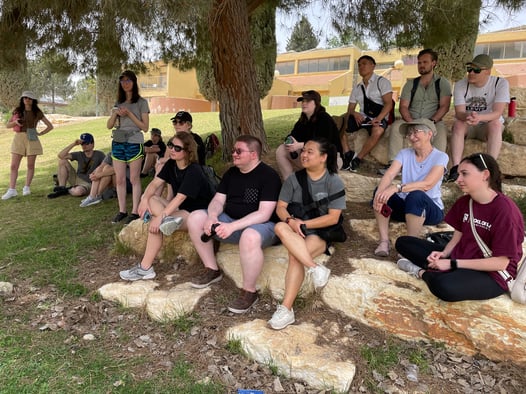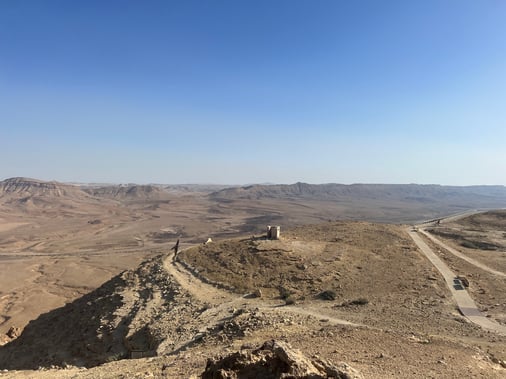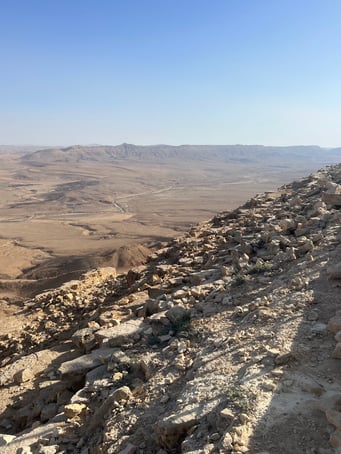Day Five – A Desert Full of Life
By: Haley Fair '25
This article is part of a series of reflections prepared by students enrolled in the Texas A&M School of Law 2023 Global Field Studies Program: Israel. Click here to visit the entire series.
We started our fifth day in Israel, and our first full day in Mitzpe Ramon, with a meeting with Dr. Emir Galilee, an expert in the social and cultural geography of nomadic and indigenous groups and tribalism in the Middle East. Dr. Galilee explained the various laws Bedouin people are subject to as Israeli citizens, as practicing Muslims, and as members of a Bedouin community. While all three sources of law are present in Bedouin communities, day-to-day life is generally governed by Bedouin law. Bedouin law is most influential in unrecognized Bedouin villages and Bedouin-established villages that are recognized by the state. Bedouin law has become less influential in daily life in the orchestrated Bedouin villages established by the state of Israel.
Dr. Galilee gave a brief overview of Bedouin law, which places an emphasis on the community (rather than the individual) and honor. During the meeting, Dr. Galilee illustrated the function of Bedouin law by dividing us into groups and discussing how various situations would affect how group members interact with each other and how the groups would interact with one another.
After our meeting, we loaded onto the bus and traveled into the heart of the city of Mitzpe Ramon. We stepped off of the bus into a picturesque succulent garden, where we met our tour guide, Yarden. She is a dance student from northern Israel who moved to Mitzpe Ramon because she fell in love with the community. On the tour we learned that, after several failed attempts to settle the land, Mitzpe Ramon was firmly established as a village when the community rallied together to create a co-op in town that supported local producers. As we met local students and business owners throughout the day, the sense that all 5,000 people in Mitzpe Ramon were part of a tight-knit community only grew.
 Enjoying the jazz performance from a small amphitheater in a local park.
Enjoying the jazz performance from a small amphitheater in a local park.
During our visit, we met two former students from the local jazz school in a park. They shared why they chose to move to Mitzpe Ramon and how the community embraced them, both as students and as residents. They were both drawn to the village because it felt like an inviting place that would foster creative expression. As they performed a jazz song for us, our group was joined by a curious dog exploring the park and people walking around paused to listen in.
 Throughout the trip we had several dogs join our tours. This pup joined us on our tour of Mitzpe Ramon.
Throughout the trip we had several dogs join our tours. This pup joined us on our tour of Mitzpe Ramon.
Just before lunch we were given the opportunity to explore the Spice Route Quarter where local artisans and companies exhibit their wares. After being turned loose to explore, almost everyone ended up at the local bakery to grab a pastry. Then, we went our separate ways to explore local shops. We gathered again at lunch, where we had time to relax and share stories from life before law school.
After we returned to the hostel, we met Dr. Elli Groner for an educational hike along the edge of the Mitzpe Ramon crater. We learned about the geological history of the crater, as well as the ecosystem that has found a way to thrive in the arid and hyper-arid crater climate. As we looked over the edge of the crater, Dr. Groner pointed out the outlines of rivers on the crater floor that were evidenced by plants that anchored themselves to the path of the fleeting water sources.
Our hike took us to the outskirts of Mitzpe Ramon, where we followed the sidewalk to a small building housing a synagogue. Inside the synagogue, we were invited to attend a Shabbat service held by a small Jewish community. A member of the community explained the service to those of us who chose to attend. At the conclusion of the service, we were invited to share in the blessing of bread.
 Dr. Groner referred to the trail from our hostel to Mitzpe Ramon as “The Edge of Life.”
Dr. Groner referred to the trail from our hostel to Mitzpe Ramon as “The Edge of Life.”
 A view of the Mitzpe Ramon crater from the trail.
A view of the Mitzpe Ramon crater from the trail.
Learn more about Texas A&M University School of Law's Global Law and Policy Program, Aggie Dispute Resolution Program, and Energy, Environmental, and Natural Resource Systems Law Program
